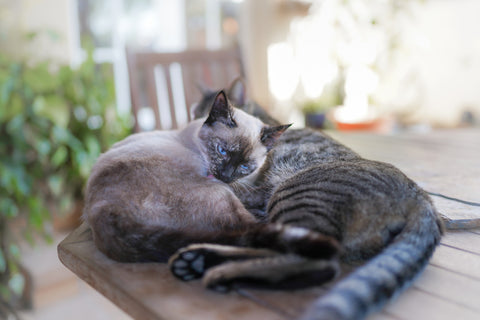
Dwarfism in cats is a condition caused by genetic anomalies which lead to stunted growth and abnormal feline body proportions. Unlike other variants of small cats, feline dwarfs are often associated with numerous health issues. While dwarfism in cats can be a result of genetic accidents, there are a few cat breeds selectively bred to promote the condition, too. Keep reading to acquire a basic understanding of this potentially harmful genetic defect.
What exactly is feline dwarfism?
There are three, subtly different varieties of small cats out there: dwarf cats, miniature cats and teacup cats. Dwarfism in cats is a rare genetic defect leading to the development of disproportional and undersized adult cats. The defect is often misunderstood and confused with miniature and teacup cats, who are sometimes incorrectly classified as dwarfs. However, miniatures and teacups, though undersized, are still cats of normal feline proportions.

Genuine dwarf cats suffer from achondroplasia, the most common type of osteochondrodysplasia. Achondroplasia is a genetic disorder of bone and cartilage which leaves a cat with a full-size body, but disproportionately short and thick legs and a large head. In humans, a mutation in the FGFR3 gene has been associated with human inherited dwarfism. This mutation causes the respective protein to be overly active, which interferes with skeletal development. However, there are still many unresolved mysteries regarding human dwarfism, and a lot of facts about feline dwarfism remain equally unknown.
Further difficulties associated with feline dwarfism
Other symptoms of achondroplasia include an undersized jaw, thick-looking joints, a curved spine and bow-legged posture. Dwarf cats can sometimes experience difficulties such as heart or lung problems, mobility difficulties and neurological issues, too. Keep in mind that all dwarf cats are prone to obesity, and because of the seriousness of their diagnosis, keeping their weight under control is vital. These cats require special care and strict supervision. Extreme cases of feline dwarfism are sometimes referred to as perma-kittens. Perma-kittens, short for permanent kittens, are cases of feline dwarfism usually coupled with serious health difficulties. The famous internet sensations, Lil Bub and Grumpy cat, are both perma-kittens who are helping raise awareness of this serious disorder.

Breeds associated with dwarfism
The ethics of selective breeding that potentially promotes dwarfism are hotly debated world-wide. The Munchkin cat is often cited to be the original dwarf breed. This is because the naturally occurring mutation causing short legs in the breed was initially thought to cause achondroplasia. However, achondroplasia is associated with enlarged heads as well as short legs – a combination of features not observed among Munchkins. Instead, the condition observed in the Munchkin cat is actually referred to as pseudoachondroplasia. Similarly to achondroplasia, pseudoachondroplasia is also a disorder of bone growth, but without the characteristic facial features.
Because many worry that this deformity can cause serious problems for Munchkin cats, there has been a lot controversy following the breed ever since it was recognized by TICA in 1995. While there is no evidence to support that the breed suffers from joint or bone problems, according to a report from 2008, there are two conditions with possibly increased incidence in the breed: lordosis (excessive curvature of the spine) and pectus excavatum (hollowed chest) (Wedderbum, 2008). Other breeds related to the Munchkin are the Napoleon (Persian x Munchkin), Skookum (LaPerm x Munchkin) and Bambino and Minskin (distinct breeds both developed by crossbreeding the Sphynx and the Munchkin).

Feline dwarfism is a very complex and misunderstood aspect of feline health and care. While many mysteries remain to be unfolded, we are hoping to contribute to better care of all cats by providing our readers with the little bit of knowledge science can provide.
Citations:
1. Wedderburn, Pete (October 2008). “Cat breeds–Trophies with hidden problems”. Journal of Small Animal Practice. BSAVA Companion. 49 (10): 7–9. doi:10.1111/j.1748-5827.2008.00680.x



